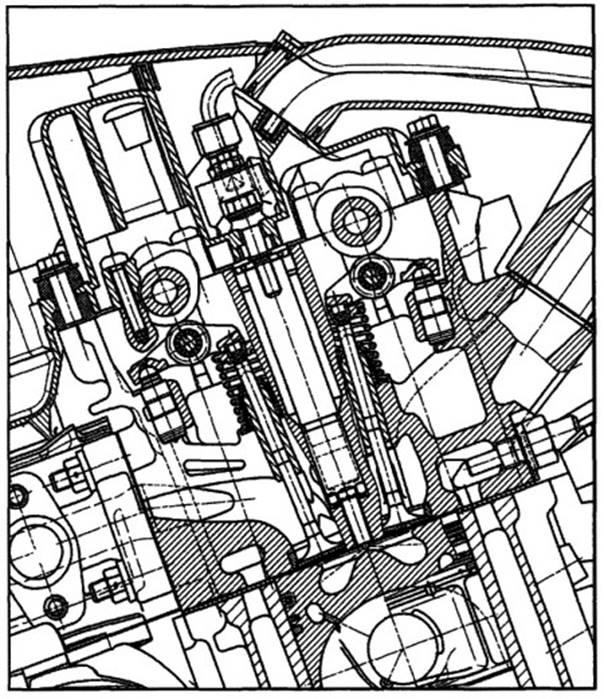Cylinder Heads for Diesel Engines
Presented as the first example of an engineering design is the cylinder head for a two-valve engine with swirl chamber. These diesel engine concepts have dictated cylinder head design ever since diesel power plants were introduced in passenger cars. Seen in the cross section through the cylinder head in Fig. 7-95 is the prechamber with the injection valve and the glow plug.

Fig. 7-95. Lateral and longitudinal sections with the installation situation for a two-valve diesel cylinder head made by BMW
The hollow-cast camshaft actuates the intake and exhaust valves (with diameters of 36 and 31 mm, respectively) via pushrods with hydraulic compensation. In passenger car engineering, this design has been used in mass production at BMW since 1983.
With the introduction of direct-injection diesel engines by Audi in 1989, the share of diesel power plants in passenger cars has risen distinctly, primarily in Europe. Four-valve technology was introduced to a greater extent to achieve even higher power densities in diesel engines, too. Because of the greatly increased ignition pressures, maximum demands for strength and durability are made on today’s diesel engine cylinder heads. Roller cam followers can be employed to minimize friction losses in the cylinder head, Fig. 7-96.

Fig. 7-96. Four-valve cylinder head with roller cam follower for a six-cylinder engine
This example shows a six-cylinder engine made by BMW, which employs this head technology in its four- and eight-cylinder engines, too. The cylinder head is fitted with swirl ports; here the air is introduced from above, through the cylinder head. The cylinder head is cast from an alloy produced in primary refining. The timing chain case is cast into the front end of the cylinder head. This lends the component significant additional strength. An exhaust gas return channel is integrated into the rear section.
The camshafts are driven by straight-tooth spur pinions, while the intake camshafts are driven by chains. The common rail injection technology used here requires two rails attached at the side of the cylinder head to supply fuel to the injection valves, which are positioned at the center of the cylinder head.
The coolant flows inside the cylinder head from the exhaust side to the intake side. To ensure that crosswise flow is maintained, the cylinder units are separated one from another by partitions inside the cooling cavity and have a water collector manifold cast as a unit on the intake side.
A further process used for diesel direct injection is the pump nozzle technique developed by Volkswagen. A separate injection pump, actuated by the camshaft, is provided for each cylinder, and this naturally has a major impact on the overall cylinder head concept, Fig. 7-97.

Fig. 7-97. Pump nozzle cylinder head made by Volkswagen
This two-valve cylinder head is equipped with push-rods with hydraulic valve play compensation. Located to the side, above the camshaft, is a bearing axis for rocker arm actuation of the pump nozzle elements. Used as the timing element is a synchronous belt that has to be fabricated from a high-strength material since the moments that the pump nozzle drive induces at the camshaft are very high. Fuel is supplied to the pump nozzle elements inside the cylinder head by one each of supply and return rails.
A vane pump driven by the camshaft delivers the required feed pressure. These pump nozzle elements can currently achieve injection pressures exceeding 2000 bar. This makes it possible to resolve the conflict of interest between low pollutant emissions and higher specific output since, even with small nozzle orifices and high injection pressures, it is possible to achieve a short injection period and rated output. Eliminating the distributor-type injection pump with its mounting bracket, drive components, and injection lines allows unification of auxiliary component arrangements on gasoline engines.
Date added: 2024-04-24; views: 714;
